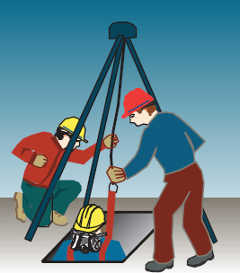

| Topic: Confined Spaces: Recognizing the Danger | |
| Date Issued: February 4, 2011 | Date Revised: March 2, 2023 |
A confined space is an area that:
All three criteria must be true for it to be considered a confined space.
A confined space is not:
About 60% of deaths in confined spaces result from oxygen deficiency and lack of air quality testing. More than half of those who died in confined spaces did so while trying to rescue fellow workers. There are four main dangers in confined spaces: oxygen deficiency or enrichment, fire or explosion, toxicity, and drowning in liquids or free-flowing solids.
As an employer, you must ensure that a code of practice is established by an employer, a contractor, or an owner of a place of employment for a confined space before permitting entry. The committee, health and safety representative, or employees if there is no committee or representative, are consulted when developing the code of practice.
New Brunswick law requires that a competent person(s) verify the opening and test the atmosphere in a confined space for oxygen level, flammable contaminants and toxic contaminants before any entry takes place. Never trust your senses of sight or smell – you cannot see, taste or smell many hazardous substances, or deficient or enriched oxygen, and you cannot hold your breath until you get out.
If the results of the tests show the atmosphere may be harmful or flammable, purging and ventilating needs to be conducted. Purging consists of displacing the existing atmosphere with agents such as air, nitrogen, water or steam. Air contaminants can also be removed, and oxygen levels corrected, by mechanical ventilation.

An entrant, one who enters the confine space
An entry supervisor is a person that is responsible to make sure that employees involved with the confined space are instructed and trained in the code of practice and the procedures identified in the code of practice before entry.
An attendant is stationed immediately outside the point of entry or exit from the confined space and continuously monitor the work in and near the confined space.
An emergency response team leader makes sure the emergency response procedures are in place and are followed by the emergency response team.
Workers exposed to hazards in a confined space must be protected from injury by PPE. An employer, contractor or owner must, in a written code of practice, identify the protective equipment that is to be used. The employer must ensure that all protective equipment has been inspected by a competent person, is in good working order and that employees comply to the legislation by wearing the required PPE. Also, where identified by the the code of practice, each entrant must wear a full-body harness attached to a lifeline that is attached to a secured anchor outside the confined space. If the entry hole is very small, wrist cuffs may be necessary.
Confined spaces often make talking difficult because of noise, distance, PPE, lighting, etc. Special equipment and techniques, such as radio, microphones, hand signals and flags, must be in place to allow communication among all personnel involved with the work.
Any confined space entry shall comply with the Occupational Health and Safety Act, General Regulation 91-191, Part XVII - Confined Space, sections 262-262.092.